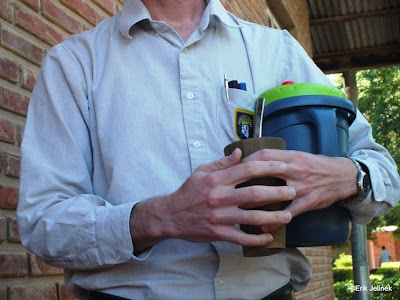Paraguay is something of a black hole as far as Latin America is concerned. Despite being in the centre of the continent and part of the Mercosur block, not only do we hear little about it, but even within South America it's something of an unknown. Furthermore it lacks any major tourist draws and so it gets bypassed by most visitors to the continent even when they're doing a so-called "Grand Tour".What actually is there in Paraguay? what are its people like (because I had never met a Paraguayan before)? how do they differ and how are they similar to their South American neighbours? These were all questions that were impatiently straining at the bit in my head; desperate to see what all the lack of fuss is about.
 |
| The spillway of the Itaipu dam, used on the rare occasions when the water level is too high. The main dam with its 20 turbines can be seen in the background. |
The main gateway to the country is Ciudad de Este, Paraguay's second city on the triple border with Argentina and Brazil. The borders are formed by the confluence of the Parana and Iguazu rivers. On the joint Brazilian-Argentinian side the cities of Foz and Puerto Iguazu make their living from the tourist draw of the awesome Iguazu waterfalls. The several hundred waterfalls span kilometres and are quite rightly considered as one of (if not the) most spectacular falls in the world. The Guaira falls on the Parana, between Paraguay and Brazil, were said to be even more spectacular, with the greatest flow of any waterfalls in the world, until they were flooded by the rising waters created by the Itaipu dam. Although the world lost a spectacular natural phenomenon, at least it was replaced by the world's largest hydropower dam (the Three Gorges Dam has a greater installed capacity, but Itaipu still produces more electricity annually) which has become a tourist spectacle in its own right, as well as providing most of Paraguay's and 20% of Brazil's electric power needs (which is roughly 0.5% of the world's electricity supply). And although I had previously visited the dam 8 years ago I wanted to go again to see how well I remembered it. Not too badly as it turns out, although I was surprised at how small the dam seemed, given its status, although much of that is probably due to the fact that even at the downtsream side of the dam the river is a whopping 60m deep, so much of the height of the dam is obscured. Though for most Brazilians Ciudad del Este is better known as the place to buy cheap electronics and household appliances. The downtown area is a warren of little shops, mostly run by Lebanese or Chinese expats selling a range of fake goods with the odd original thrown in to put the consumer off balance The city's beat is synchronised to a Brazilian rhythm, with businesses opening at 7am and closing by 3pm thanks to the one-hour time difference and general afternoon crush to get back over the bridge to "civilisation", whilst the remaining Paraguayans return to their more tranquilo pace of life.
While its larger neighbour is progressing economically in leaps and bounds Paraguay doesn't seem to see the point in hurrying so much, and why don't you just sit down and share a mug of tereré. For tereré is a national institution and rarely will you see a Paraguayan without their thermos tucked under their arm, guampa (drinking vessel, often made of horn or metal and clad in leather) in hand and sucking avidly on the bombilla (metal straw with filter on the end). The mate leaves are rich in caffeine and said to be healthier than drinking coffee, though I just found it somewhat bitter. Nevertheless the ritual of sharing a guampa in a circle is the glue that binds Paraguayan society together and you cannot say you've truly visited until you've had a few rounds whilst lazing on a porch.
Making the transition from Brazil to Paraguay I was greatly helped thanks to a chance encounter I had in Brazil, of the type that pop up every once in a while and change the direction and mood of a trip. Whilst I was standing outside a small town in
Minas Gerais trying, unsuccessfully, to hitch a ride to Belo Horizonte, I
spotted two men on bicycles puffing up the hill towards me. I called
out to them to ask whether there was a better hitch spot down the road.
They stopped and replied in Portuguese that there wasn't and that my
spot was good. They asked me where I was from to which I replied Czech
Republic (since that is the passport I'm currently travelling on), and
then they said that we're neighbours. It turns out that they were
German. From East Germany to be exact, and that they had cycled away
from Germany back in 1990 almost as soon as the Wall had fallen ... and
just kept on going.
The pair (Axel and Peter) have since settled down a bit and got married
but still travel regularly. Axel currently lives just outside Ciudad
del Este with Leide, his Brazilian wife. And so, on a scrap of paper he
drew a hasty map of how to find his place and told me to come and find
him when I finally made it there. Find it I did, and although he had not
yet returned himself, he had warned Leide and so I was warmly welcomed
and given a place to slow down from the hectic pace of Brazil and
acclimatise myself to the more sedate nature of Paraguay.

No comments:
Post a Comment